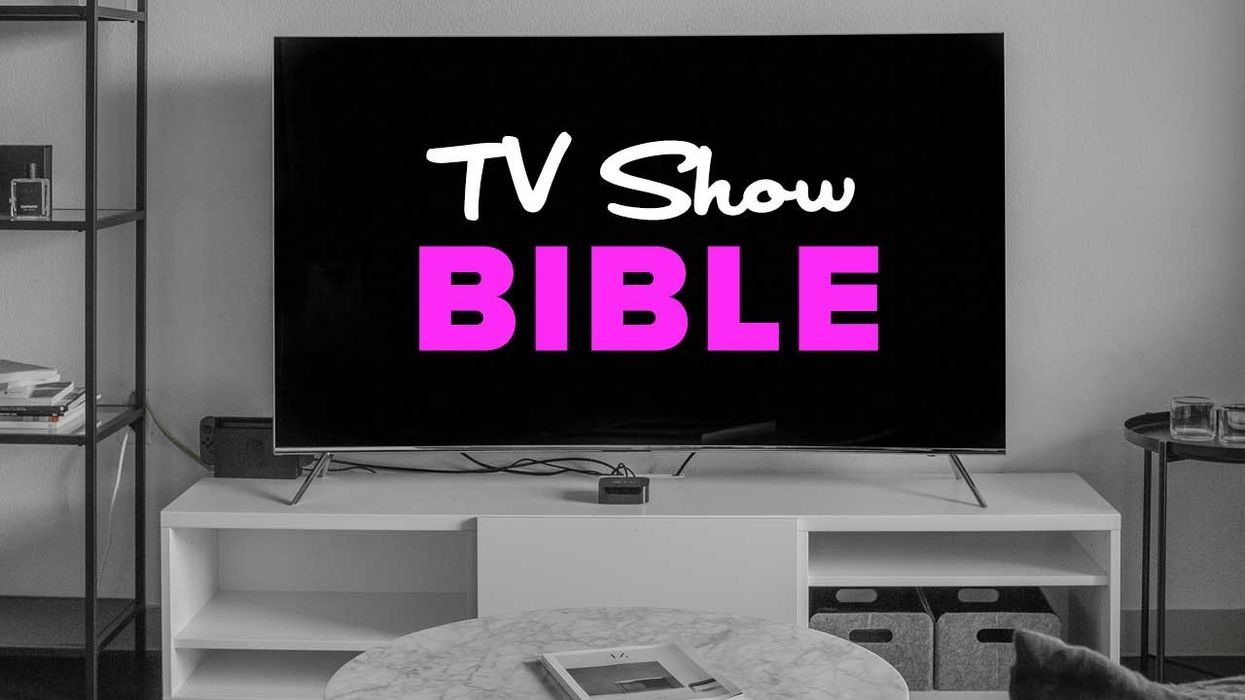How to Write a TV Show Bible (w/ Template)
Writing a TV show bible is the first step in seeing your idea go from paper to the screen. It's also the document that will ensure executives and future staffed writers know what's going on. But how do you make one?

Writing a television show is a massive undertaking. You have to plan out the arcs of multiple characters and make sure you have enough developed plotlines to sustain not only one season but multiple seasons. You can't just keep track of this stuff in your head. You need to put it all on paper, not only for yourself but for the producers and executives you want to be a part of the show. And for your future staff of writers. But where do all these ideas live?
The answer to that question is the TV series bible. You need a bible to pitch your TV series, and if the pitch gets picked up you'll need one even more. Television shows are humungous things to keep track of, but the bible keeps everyone on the same page, so to speak.
Today we'll go over TV bibles, look at a few examples of them, and even provide you with a free tv bible template you can use for your writing.
What is a TV Show Bible?
The best way to describe a tv show bible is that it needs to be an in-depth, detailed, and structured version of your complete vision of the television show you are pitching.
A TV show bible is a formal document used to track the characters, arcs, episodes, and seasons of a TV show. When you're pitching a TV show, the bible is part of your pitch packet, along with the pilot and any other materials. Once your TV show is picked up, the series bible becomes a living document for you to track what happens inside every season.
Each bible is anywhere from 10-50 pages, depending on your idea. I try to keep mine below twenty pages. You can check out the examples later to see how the pros do it.
Why does your series need a bible?
When you pitch a TV show, you usually only have 10-15 minutes to get the idea across. Sure, you'll usually leave behind a TV pilot for them to read, but you want the readers to be able to unpack your vision as well. This is your chance to write a document that gives us the full tone and story behind the pitch. It also is a great place to aggregate information as your idea grows. Executives want tangible proof that they're spending money on the right thing. This helps them also sell legal and the network on why this thing should hit the air. All in all, aside from your pilot, it's the most important document in your repertoire.
The TV Show Bible Template
I have pitched a few tv shows (still waiting for that elusive sale) and wanted to let you in on how I format a bible. I didn't pull this out of my ass, I aggregated what I liked seeing in professional bibles and tweaked a few sections to be amenable to modern sales tactics. This template is designed to streamline your concentration and keep the executives reading it focused on how your story builds, from the germ of an idea, or logline, to multiple seasons of episodes.
So check it out!
You can easily copy and paste these ideas into your writing program of choice by selecting and pasting the TV bible template below. Then fill the answers for your tv show.
TITLE
By FIRST NAME LAST NAME
Introduction:
Why did you choose to write this story? What inspired it?
Structure and Tone:
Traditional three or five acts? Flashbacks? Flash-forwards? Other plot devices? What’s the one of the story. How do you balance that tone in extreme circumstances?
What’s the Theme?
Tell us what you show is really about.
Characters/Arcs
NAME: Give us details about they are when we meet them and where you want to take them over the course of the season.
*Include all major players
Season One:
Summary of what's ahead.
TWO.
Summary of each episode - 1 -3 paragraphs
THREE.
FOUR.
FIVE.
SIX.
SEVEN.
EIGHT.
NINE.
TEN.
Where do we go from here?
Season Two:
Summary of the next season and character arcs - 2 to 4 paragraphs
Season Three:
Summary of the next season and character arcs - 2 to 4 paragraphs
Beyond:
Give us a hint at how you see the show playing out and what you want people to learn at the end of the story.
TV Show Bible Example
Now that you have a template for your TV show bible, let's look at some examples of TV show bibles and how they tackle the format we provided. Again, I'm giving this all away for free - I'm not trying to sell our format. So if you have a section you like better or want to add more sections, go for it.
Batman: The Animated Series
We had seen Batman in many iterations when this show came out. So this first page helped anyone reading the bible help totally understand what the goal was of this series and how they would treat the concept of Batman.
Stranger Things
What about something original? Stranger Things had to set up the story with a one-page summary right away. This kind of story summary is a great way to let your audience know the view from 10,000 feet. It allows them to be excited for the details to come and the deeper description that will follow.
Freaks and Geeks
I talked a lot about endearing yourself to executives that are reading these documents. This one is written in the tone of the show and also gets on our good side. I didn't know those people. I want to know the real people and I want to watch a show that amplifies those real people because they are just like me.
Carnivale Pitch Packet
Once you get into the characters you really want to let your voice shine here. Look at the way Carnivale makes sure these are poetic and emblematic of the mysticism at the center of the show.
New Girl
What if you want to write something funnier? New Girl's character descriptions are an excellent way to make your audience laugh and understand who these characters are. You want protagonists that pop off the page. Let us know why we want to hang out week in and out.
The Wire
The Wire does a great job breaking down the massive list of characters by where we will meet them. This list isn't of cops or politicians, but of the people we're going to meet in the projects of Baltimore. We understand the hierarchy here as well as the smaller hurdles each person will go through as the story progresses.
Fargo
I mentioned intangibles earlier, so I picked a weird show to be our example. I love Fargo so much. The bible for the show is excellent and helps the reader understand the circular, err triangular setup of the season. It's also a great image to shake up all the words we've been reading. Never underestimate the power of an image to convey a thought and make people feel like the experience is curated toward them.
Grey’s Anatomy
Once you're through the intros and characters you're going to have to talk about the season. So each episode gets a short synopsis of what will happen inside it. Your season might be five episodes, or seven or 10, or 12, or 24. The point is, just give us the story and tell us what we will see happening.
Star Trek: Enterprise
If there are some aspects we need to understand, like tech, that matters in your story, You want to put them before or after the episodes, depending on when you think the reader needs that information. Especially if it is pertinent to plot devices or what's happening.
True Detective
Finally, we're trying to make multiple seasons here. So make sure you always leave the reader with a clear pathway forward. Where is this show headed? What can we expect watching for multiple years down the line?
As you can see, these examples are super different from one another, but the one thing they have in common is that each conveys the tone and personality of the TV show. So stop reading and get writing!
What's next? Learn how to pitch a TV show!
Now, more than ever, you need to know how to pitch a TV show. Every network and streamer needs content. So it's time to learn how to develop your TV ideas. Do you have a great TV show idea? How can you get it in the right hands? It might be time for you to master the TV show pitch and to write your pitch treatment to get it ready for the room.
Click the link to learn more!
- Learn to Write a TV Show Bible With Our Show Bible Template ›
- How to Write a Film Treatment (with Examples) ›
- How to Pitch a TV Show to Any Network or Streamer (Free Checklist) ›
- 34 TV Bible Examples for Screenwriters ›
- How to Write a TV Show Pilot (Drama or Sitcom) ›












 'The Amazing Spider-Man' (2012)
'The Amazing Spider-Man' (2012) 'Jaws' (1975)
'Jaws' (1975)









